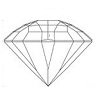16.32: Diaspore
- Page ID
- 4716
| Diaspore | |
|---|---|
| Chemical composition | AlO(OH) |
| Crystal system | Orthorhombic |
| Habit | Tabular, sometimes fibrous |
| Cleavage | Perfect to imperfect |
| Fracture | Conchoidal |
| Luster | Bright vitreous to pearly (on cleavage surface). |
| Hardness | 6.5 - 7 |
| Optic nature | Biaxial + |
| Refractive index | 1.682 - 1.752 |
| Birefringence | 0.040 - 0.048 |
| Specific gravity | 3.2 - 3.5 |
| Lustre | Vitreous |
| Pleochroism | Moderate |

Figure \(\PageIndex{1}\): Color-changing diaspore from green in daylight to brown in incandescent light - also known as “Zultanite” in the gem market.
Photo courtesy of Chaman Golecha, Gem Testing Laboratory, Jaipur.
Diaspore as a plausible gemstone has been reported first around 1977 when a large enough crystal was examined at the Gem Testing Laboratory in London. This, usually colorless, material showed good color-change from pale bluish-green to pale pinkish-brown. Turkey was the origin of this color-change material. When Zultanite Gems LLC acquired the mining location, this color-change variety of diaspore was marketed under the tradename "zultanite®". At present (2007) sole distribution rights of "zultanite®" are granted to GemsTV.
Chemical composition
AlOOH + Mn (or Fe) as impurity (a dimorph of boehmite).
Mn or Fe may substitute Al in the lattice.
Crystallography
Orthorhombic.
Habit: crystals are elongated plates (tabular); acicular needles also massive; foliated.
Diagnostics
Diaspore may be confused with peridot due to the strong doubling of back facets, but diaspore is usually much paler in color. Iron-rich green sapphire has an absorption spectrum close to diaspore.
Color
Colorless, pale bluish-green to pale green, pale pinkish-brown to pale brown.
Diaphaneity
Transparent to opaque.
Specific Gravity
S.G.:3.2 - 3.5 (mean = 3.4)
Cleavage
Perfect in one direction {010} and imperfect on {110} and {210}.
Refractometer
Optic nature: Biaxial positive.
Refractive index range: nα = 1.682 - 1.702, nΒ = 1.705 - 1.725 and nγ = 1.730 - 1.752. Mean = 1.702 - 1.750.
Maximum birefringence: 0.040 - 0.048.
Spectrum
Not diagnostic but Turkish stones 471, 463, 454 (much similar to iron-rich sapphire).
Luminescence
UV fluorescence: May show dull pale yellow (LW) and green (SW)
Pleochroism
Strong depending on body color and source. Blue / Pale green and rose to dark red.
Magnification
Diaspore is a type II stone on the GIA clarity scale, hence small inclusions are usually found.
Phenomena
- Color-change
- Cat's-eyes
Simulants
| Sapphire | No strong doubling of facets; higher heft; higher R.I., unixial figure. |
| Sillimanite | Lower S.G., lower RI and lower birefringence. |
| Peridot | Lower RI and slightly lower birefringence. |
Occurrence
Geological occurrence:
In metamorphosed limestones, chloritic schists and altered igneous rocks. Also in bauxite deposits.
Geographical locations:
Memaris, Turkey (gemmy pale brown); Chester, Massachusetts (with corundum); Pennysylvania (fine transparent colourless to brown); Hungary; South Africa in Postmasburg district - Manganiferous variety; Cornwall, England; Greenland; Norway; Sweden; France; Switzerland; Germany; Greece; USSR; Japan; China; Turkey.
References
- Gems Their Sources, Descriptions and Identification 4th Edition (1990) - Robert Webster (6th ed.)
- Colour Encyclopedia - J.E. Arem ISBN 0412989115
- Textbook of mineralogy - E.S. Dana
- Introduction to Optical Mineralogy 3rd edition (2003), Prof. W.D. Nesse


